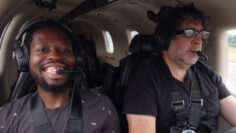Flight Safety
The aviation industry prizes safety above all else—it’s their bedrock. Airlines and aviation authorities across the globe are fiercely committed to safeguarding their passengers, crew, and mighty birds in the sky. Over the years, technology has soared, safety regulations have tightened, and our skies have become significantly safer. But to further bolster flight safety, it’s paramount that everyone in the aviation loop understands the factors at play and the safeguards designed to mitigate risks.
So fasten your seatbelt and prepare for takeoff as we journey into the world of flight safety. We’ll explore its various facets, the factors that affect it, and the rules and guidelines designed to fortify it. We encourage you to join the conversation, add your own insights, and help deepen our collective understanding of flight safety.
The ABCs of Flight Safety
To understand flight safety, picture it as an intricate tapestry woven from several threads—each one representing a principle, practice, or safeguard aimed at reducing the inherent risks of air travel. These protective layers shield us from hazards like accidents, technical snafus, and external threats. It’s a holistic approach that encompasses everything: pilot proficiency, aircraft maintenance, the watchful eyes of air traffic control, weather conditions, security measures, and the human touch—all vital components for safeguarding our skies.

The Ingredients of Flight Safety
Pilot Training and Experience
Let’s start with the men and women at the helm. The skill and experience of pilots are the cornerstone of flight safety. Before they can take to the skies, pilots undertake rigorous training programs that fuse theoretical knowledge with simulator sessions and real flight hours. This intense preparation hones their abilities to handle an array of scenarios, developing critical decision-making skills necessary for flight.
The Importance of Aircraft Maintenance
The health and wellbeing of an aircraft are also pivotal. Airlines and maintenance crews follow a stringent regimen to ensure aircraft are kept in top-notch condition. Regular inspections, timely component replacements, and adherence to manufacturer-recommended maintenance schedules are all part of a meticulous protocol designed to spot and rectify issues before they can jeopardize flight safety.
The Role of Air Traffic Control
Don’t forget about air traffic control. They’re like the guardian angels of our skies, continuously monitoring and managing aircraft movement, making sure planes keep a safe distance from each other, and following the flight paths as planned. Their timely instructions and alerts help prevent air collisions and ensure a seamless flow of air traffic.
Weather Conditions
Mother Nature also plays her part. Weather conditions, be it thunderstorms, fog, strong winds, or icing, can present significant challenges to flight safety. But thanks to advanced weather forecasting systems and meteorological reports, pilots and air traffic controllers can make informed decisions about flight routes, altitude adjustments, or even delays and diversions to maintain safety.
Security Measures
In the era we live in, security measures are more critical than ever. Stringent protocols—passenger and baggage screenings, restricted access to aircraft, and thorough background checks—all aim to deter potential threats. These measures work hand-in-hand with intelligence networks and coordination between national and international security agencies to nip potential threats in the bud.
The Human Factor
Last but not least, we humans also have a significant role. Our performance, communication, fatigue management, and workload distribution can greatly influence flight safety. Addressing human limitations, instilling robust training, and fostering an open culture of error reporting are all crucial in mitigating the risk of human errors in aviation.
The Armor of Flight Safety: Procedures and Regulations
Pre-flight Inspections
Prior to any journey, pilots and ground crew conduct a thorough sweep, inspecting the aircraft’s exterior, interior, control surfaces, fuel systems, landing gear, and other vital components. Anything out of place, any little hiccup or discrepancy, is promptly addressed to guarantee the aircraft’s readiness for flight.
Safety Briefings
Safety briefings are a cornerstone of flight safety procedures. Before we can leave the tarmac, flight attendants brief passengers on key safety information, such as how to fasten seatbelts, locate emergency exits, and use oxygen masks. These briefings empower passengers with knowledge, preparing them to react appropriately during emergencies.
Emergency Protocols
In-flight emergencies can be terrifying. But fear not. Airlines have extensive emergency procedures to handle everything from engine failures to fires or severe weather encounters. Pilots and cabin crew undergo specialized training to tackle these situations, and aircraft are equipped with essential safety systems and equipment to ensure passengers and crew are safe even in critical circumstances.
Aviation Authorities and Organizations
Aviation authorities and organizations worldwide serve as the custodians of flight safety. They establish and enforce a whole host of regulations, standards, and best practices, covering all aspects of aviation, from pilot training and aircraft maintenance to air traffic control and security. These organizations work in unison, creating a harmonized approach to flight safety across the industry.

International Safety Standards
International aviation bodies, like the International Civil Aviation Organization (ICAO), contribute to global safety by laying out guidelines and standards. These universally accepted norms cover everything from operational procedures to airworthiness requirements, promoting a unified approach to safety, no matter the country or region.
Unraveling FAQs (Frequently Asked Questions)
FAQ 1: What measures ensure pilot competence?
Pilot competence is assured through exhaustive training programs, continuous skill evaluations, immersive simulator sessions, and requirements for ongoing professional growth. Regular checks and assessments by airlines and regulatory authorities also keep pilots on their toes, ensuring their knowledge, skills, and compliance with safety protocols remain top-notch.
FAQ 2: How is aircraft maintenance regulated?
Regulation of aircraft maintenance lies in the hands of aviation authorities such as the Federal Aviation Administration (FAA) in the U.S. or the European Union Aviation Safety Agency (EASA) in Europe. These authorities mandate maintenance requirements, perform audits, and certify maintenance organizations, making sure they’re up to par with safety standards and protocols.
FAQ 3: How crucial is air traffic control to flight safety?
Air traffic control is like the conductor of a massive airborne symphony, managing the safe and orderly flow of aircraft in controlled airspace. Controllers guide pilots with instructions, keep tabs on aircraft positions, and ensure planes keep a safe distance from each other—preventing mid-air mishaps and maintaining smooth air traffic.
Parting Thoughts
The aviation industry leaves no stone unturned when it comes to flight safety—it’s their holy grail. Multiple facets—pilot training, aircraft maintenance, air traffic control, security measures—work in unison to keep risks at bay and uphold the gold standard of safety. By understanding these factors and sticking to established procedures and regulations, we continue to elevate flight safety, making air travel one of the safest ways to get from point A to point B.
We’d love to hear your take on flight safety. Feel free to share your thoughts and comments below. And, don’t keep this information to yourself—share this article on your preferred social media platforms to help spread the word about flight safety. If you’re interested in diving deeper, our recent article, “What Is Air Traffic Control,” is a must-read.
Join the Conversation
Your thoughts and insights on flight safety matter to us. Share your comments below and help us keep the conversation going. Spread the word by sharing this article on your social media accounts. Together, let’s raise awareness and understanding of flight safety. If you enjoyed this piece, don’t miss our recent article on “What Is Air Traffic Control”—it’s a great deep dive into another fascinating aspect of the aviation industry. Thanks for joining the discussion—we look forward to your contributions!







